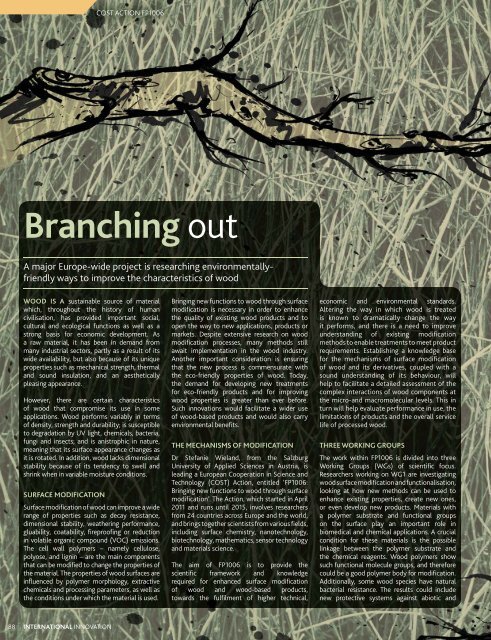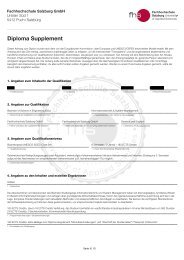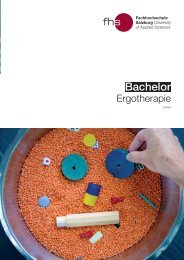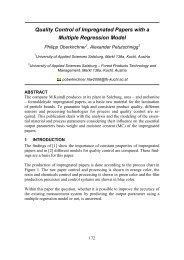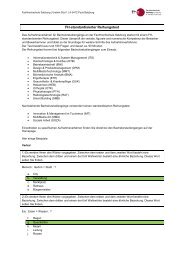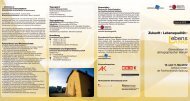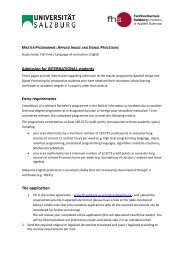Wonders ofwood
Wonders ofwood
Wonders ofwood
Create successful ePaper yourself
Turn your PDF publications into a flip-book with our unique Google optimized e-Paper software.
COST ACTION FP1006<br />
Branching out<br />
A major Europe-wide project is researching environmentallyfriendly<br />
ways to improve the characteristics of wood<br />
WOOD IS A sustainable source of material<br />
which, throughout the history of human<br />
civilisation, has provided important social,<br />
cultural and ecological functions as well as a<br />
strong basis for economic development. As<br />
a raw material, it has been in demand from<br />
many industrial sectors, partly as a result of its<br />
wide availability, but also because of its unique<br />
properties such as mechanical strength, thermal<br />
and sound insulation, and an aesthetically<br />
pleasing appearance.<br />
However, there are certain characteristics<br />
of wood that compromise its use in some<br />
applications. Wood performs variably in terms<br />
of density, strength and durability; is susceptible<br />
to degradation by UV light, chemicals, bacteria,<br />
fungi and insects; and is anistrophic in nature,<br />
meaning that its surface appearance changes as<br />
it is rotated. In addition, wood lacks dimensional<br />
stability because of its tendency to swell and<br />
shrink when in variable moisture conditions.<br />
SURFACE MODIFICATION<br />
Surface modification of wood can improve a wide<br />
range of properties such as decay resistance,<br />
dimensional stability, weathering performance,<br />
gluability, coatability, fireproofing or reduction<br />
in volatile organic compound (VOC) emissions.<br />
The cell wall polymers – namely cellulose,<br />
polyose, and lignin – are the main components<br />
that can be modified to change the properties of<br />
the material. The properties of wood surfaces are<br />
influenced by polymer morphology, extractive<br />
chemicals and processing parameters, as well as<br />
the conditions under which the material is used.<br />
Bringing new functions to wood through surface<br />
modification is necessary in order to enhance<br />
the quality of existing wood products and to<br />
open the way to new applications, products or<br />
markets. Despite extensive research on wood<br />
modification processes, many methods still<br />
await implementation in the wood industry.<br />
Another important consideration is ensuring<br />
that the new process is commensurate with<br />
the eco-friendly properties of wood. Today,<br />
the demand for developing new treatments<br />
for eco-friendly products and for improving<br />
wood properties is greater than ever before.<br />
Such innovations would facilitate a wider use<br />
of wood-based products and would also carry<br />
environmental benefits.<br />
THE MECHANISMS OF MODIFICATION<br />
Dr Stefanie Wieland, from the Salzburg<br />
University of Applied Sciences in Austria, is<br />
leading a European Cooperation in Science and<br />
Technology (COST) Action, entitled ‘FP1006:<br />
Bringing new functions to wood through surface<br />
modification’. The Action, which started in April<br />
2011 and runs until 2015, involves researchers<br />
from 24 countries across Europe and the world,<br />
and brings together scientists from various fields,<br />
including surface chemistry, nanotechnology,<br />
biotechnology, mathematics, sensor technology<br />
and materials science.<br />
The aim of FP1006 is to provide the<br />
scientific framework and knowledge<br />
required for enhanced surface modification<br />
of wood and wood-based products,<br />
towards the fulfilment of higher technical,<br />
economic and environmental standards.<br />
Altering the way in which wood is treated<br />
is known to dramatically change the way<br />
it performs, and there is a need to improve<br />
understanding of existing modification<br />
methods to enable treatments to meet product<br />
requirements. Establishing a knowledge base<br />
for the mechanisms of surface modification<br />
of wood and its derivatives, coupled with a<br />
sound understanding of its behaviour, will<br />
help to facilitate a detailed assessment of the<br />
complex interactions of wood components at<br />
the micro-and macromolecular levels. This in<br />
turn will help evaluate performance in use, the<br />
limitations of products and the overall service<br />
life of processed wood.<br />
THREE WORKING GROUPS<br />
The work within FP1006 is divided into three<br />
Working Groups (WGs) of scientific focus.<br />
Researchers working on WG1 are investigating<br />
wood surface modification and functionalisation,<br />
looking at how new methods can be used to<br />
enhance existing properties, create new ones,<br />
or even develop new products. Materials with<br />
a polymer substrate and functional groups<br />
on the surface play an important role in<br />
biomedical and chemical applications. A crucial<br />
condition for these materials is the possible<br />
linkage between the polymer substrate and<br />
the chemical reagents. Wood polymers show<br />
such functional molecule groups, and therefore<br />
could be a good polymer body for modification.<br />
Additionally, some wood species have natural<br />
bacterial resistance. The results could include<br />
new protective systems against abiotic and<br />
88 INTERNATIONAL INNOVATION


